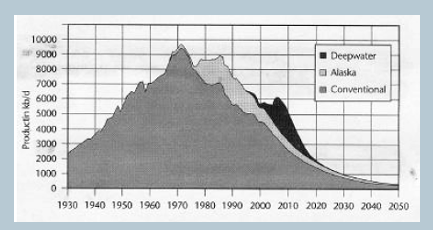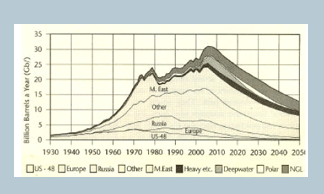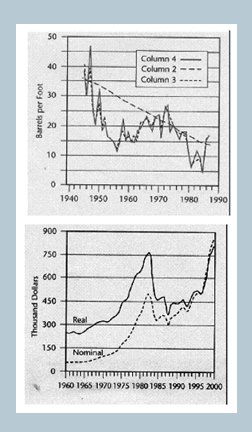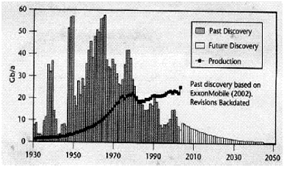|
SUNDAY EDITION January 18th, 2026 |
|
Home :: Archives :: Contact |
 |
Peak Oil, China, & India Will Send Oil Prices to the MoonJay Taylor "It is evident that the fortunes of the world's human population, for better or for worse, are inextricably interrelated with the use that is made of energy resources." (M. King Hubbert - 1969) "There is no substitute for energy. The whole edifice of modern society is built upon it...It is not 'just another commodity' but the precondition of all commodities, a basic factor equal with air, water, and earth."E. F. Schumacher - 1973) "The Allies were carried to victory on a flood of oil...With the commencement of the war, oil and its products began to rank as among the principal agents by which they would conduct, and by which they could win it. Without oil, how could they have procured the mobility of the fleet, the transport of their troops, or the manufacture of several explosives?"(Britain's Foreign Minister, Lord Curzon, commenting on the reason for the Allied victory in WWI) There is no doubt in your editor's mind that empires cannot exist without control of the world's oil supplies. If you don't believe that, I would strongly suggest you read A Century of War, by F. William Engdahl. He points out that the rise of the existing Anglo-American empire was made possible by wrestling petroleum resources away from Germany prior to WWI. After WWI, the victors not only sucked the lifeblood out of Germany by imposing reparations three times the amount it could possibly pay, but in the process they deprived Germany of oil and other resources it needed to rebuild its economic interests. And so we had World War II, which set the stage for the existing Anglo-American empire and the major global institutions such as the World Bank, IMF, BIS, and United Nations that have continued to assist the U.S. and England in controlling the existing supplies of oil. Whenever various countries try to exercise their own sovereign rights to do as they wish with their own oil, and when those actions get in the way of the large corporate and banking interests of the Anglo-American empire, either covert or overt military action is taken to unseat the sovereign rights of those nations. The first example of that after WWII took place in Iran when that nation elected Dr. Mohammed Mossadegh as its leader in 1951. Mossadegh won election on a platform that would have required the Anglo-Iranian Oil Company to share profits on a 50/50 basis. The British did not want any part of that so it went to the Eisenhower Administration, and the CIA was put into action to overthrow Mossadegh, at which time Reza Shah Pahlavi was put into power-ensuring the oil would again flow to Anglo-American interests. In A Century of War, the author points out how Israel was implemented in Palestine as a means of enabling the Anglo-American empire to maintain a toehold in this oil-rich region of the world. As a result we in the American empire have managed to live an opulent lifestyle while the rest of the world lives in poverty. "The skylines lit up at dead of night, the air-conditioning systems cooling empty hotels in the desert, and artificial light in the middle of the day all have something both demented and admirable about them: the mindless luxury of a rich civilization, and yet of a civilization perhaps as sacred to see the lights go out as was the hunter in his primitive night."(Jean Baudrillard - 1989) American and western European opulence have prevailed over the past 60+ years. We Americans have come to think it our natural-born right to be able to drive huge SUVs while most of the world lives in relative poverty. But our materialistic view of the world is on a collision course with a new reality that will be forced on us and will reduce our standard of living. The new reality I speak of is derived from a combination of declining production of oil, especially cheap oil, and rising competition from huge numbers of middle-class people from places like China and India as well as other lesser-developed countries. We are going to continue to pay much more for oil, as various geopolitical interests compete for dwindling supplies of oil, and as central bankers print more and more money in a self-deceptive move to try to pretend to society that we can afford expensive oil. Peak Oil as China and India Growth Rates Explode 
Another book I have recently read and highly recommend that you read is, The Party's Over, by Richard Heinberg. This book discusses the arguments for and against Peak Oil, though the author admits he is a believer in peak oil theory. Unless there is some grand deception afoot to distort data on a wide front by a large number of people, in my view, peak oil theory has great credibility. Tellingly, it is the geologists who hunt for oil who are the strongest believers in peak oil, while economists who live in their theoretical world tend to dismiss claims that modern civilization is facing an energy, and thus an economic, crisis of epic proportions. Let's take a look at some of the evidence presented in Mr. Heinberg's book. During the 1920s, oil was discovered in western Pennsylvania. The relatively short life of those wells caused geologists and folks in general to believe in the notion that oil wells had a very limited lifespan. But then came some huge discoveries in western Texas and in the Persian Gulf that led people to scoff at the notion that we would need to worry any time soon about limited oil supplies.One person who did not scoff at that notion was Marion King Hubbert, who became one of the best-known geophysicists in the world because of his disturbing prediction first announced in 1949 that the fossil-fuel era would prove to be very brief. He had actually started to do some work on petroleum and natural gas reserves while he was a student at the University of Chicago in 1926. In 1949, he used statistical and physical methods to calculate total world oil and natural gas supplies and documented their sharply increasing consumption. Then, in 1956, on the basis of his reserve estimate and his study of the lifetime production profile of typical oil reservoirs, he predicted that the peak of crude-oil production in the U.S. would occur between 1966 and 1972. At the time, most economists, oil companies, and government agencies, including the USGS, dismissed the prediction. But in fact, oil production did peak in 1971, as shown on the chart above. Roughly speaking, the production of oil from wells occurs over time on a normal distribution curve, as early production is slow until a peak is hit at about halfway through the life of a well and then declines begin to occur. With oil discoveries and heavy consumption taking place first in the U.S., and with an absence of wars to deter production, and with modern technologies being used first here, production from the lower 48 states has peaked earlier than international production, which is pictured on your left. 
One of Hubbert's chief followers is Colin J. Campbell. After earning his Ph.D. at Oxford in 1957, Campbell worked first for Texaco and then Amoco as an exploration geologist, his career taking him to Borneo, Trinidad, Colombia, Australia, Papua New Guinea, the U.S., Ecuador, the U.K., Ireland, and Norway. He later was associated with Petroconsultants in Geneva, Switzerland, and in 2001 brought about the creation of the Association for the Study of Peak Oil (ASPO), which has members affiliated with universities in Europe. He published extensively on the subject of petroleum depletion, and is author of the book The Coming Oil Crisis. Campbell's most prominent and influential publication was the article "The End of Cheap Oil?"which appeared in the March 1998 issue of Scientific American. That article concluded the following: From an economic perspective, when the world runs completely out of oil is...not directly relevant: what matters is when production begins to taper off. Beyond that point, prices will rise unless demand declines commensurately. Using several different techniques to estimate the current reserves of conventional oil and the amount still left to be discovered, we conclude that the decline will begin before 2010.
The chart of actual production as well as projected future production is noted above. Taken into consideration here are supplies of heavy oil and deepwater sources as well as assumptions of polar exploration as well. If this chart is close to being accurate-and I believe it is-then global supplies of oil are beginning to decline just as tens of millions of higher energyconsuming middle-class folks in China and India begin to enjoy the luxuries we in the West have known for decades. But can't we find more oil if we simply look harder for it or if we opened up areas off the coast of the U.S. and in Alaska that have been off limits for so long? No doubt we would find some additional supplies of oil if we drilled for more in these off-limit places, but a stunning and sobering fact that we need to deal with is that it is becoming increasingly expensive and non economic to explore for oil and gas, as the two charts on your right illustrate. The top chart shows the decline in barrels of oil found per foot of drilling. Prior to 1950, between 30 and 52 barrels of oil were found per foot of drilling. Since 1980, that number has ranged between 5 and 12 barrels of new oil per foot of drilling! The chart on your right tracks the cost per oil and gas well. What we are interested in here is the real cost after factoring out inflation. That figure is shown in the solid black line. Note how these costs per well have jumped from approximately $225,000 per well in 1960 to considerably over $800,000 per well in 2000. Moreover, the following illustration (which measures the net present value of oil and gas discoveries versus the net present value of exploration and development expenditures) shows that there is no good reason to continue exploring for oil and gas, because the returns (expressed in the net present value of exploring and developing as opposed to the net present value of oil and gas to be produced in the future) have turned negative over the past couple of years. In other words, factoring in the time value of money, on average it now costs more to explore and develop oil and gas wells than revenues that are returned out of the ground.
 Amazingly, about 80% of the oil consumed today was discovered before 1973. But most Americans could care less about the declining discoveries of new oil supplies as long as they can afford to keep fueling up their SUVs. And even though the price of oil has been on the rise, so far there have been no shortages as production continues to rise. The chart on your right, however, which shows past and future discoveries of oil and existing production, suggests that while consumers may not care now, it won't be long before they do, because if these statistics are in fact true, it is only a matter of time before there will be a substantial reduction in the quantity of oil available to the markets. If/when that takes place, one of two outcomes can be expected. If central bankers around the world choose not to accommodate their economies by cutting back on the creation of new money from thin air, the global economy is likely to be thrust into a global depression the likes of which we have not seen in the West since the 1930s. If, as now appears more likely, central bankers continue to print more and more money in an illfated attempt to accommodate higher oil prices, we may well be facing a hyperinflationary scenario, as independent economist John Williams has predicted. Interestingly, John is predicting hyperinflation around the year 2010, a time by when we would expect oil supplies to start declining rather dramatically. (For more on John William's theories , subscribe to J Taylor's Gold & Technology Stocks, and we will send you a complimentary copy of an article we published in last weekend's Hotline message that lays out the arguments for an impending hyperinflation in America.) Of more immediate concerns are tensions now brewing in the Middle East again over disagreements with Iran. With regard to that issue, I would direct your attention for a second time to the words of Britain's Foreign Minister, Lord Curzon, who recognized that oil supplies were crucial to the success of the Allied Powers in WWI. Modern-day empires require oil to sustain themselves. Iran seeks to preserve its own oil supply, which will in time be inadequate to meet its own needs. And so it seeks to establish nuclear power plants to preserve this precious resource. As Scott Ridder has recently written, the chance of nuclear power plants in Iran leading to its threat to the U.S. is slim to none. What is at stake here is the continued domination of the post-World War II Anglo-American centric
global power structure. If the U.S. loses its ability to access oil from the Middle East, it will be finished
as the world's lone superpower. In A Century of War, F. William Engdahl points out oil is the reason we
are in Iraq and is why England and the U.S. forced Palestinians off their land and created Israel in 1948.
The following chart shows why it is so imperative, for the preservation of the Anglo-American empire,
that the oil keeps flowing from the Middle East. The reliance of the U.S. on imported oil gave rise to Iranian political in the in the 1970s and to the overthrow of the Shaw, America's choice dictator because he co-operated with America's global interests. As the chart above shows, U.S. imports are now far greater than ever before, so that any disruption in that part of the world could bring about disastrous consequences for the global economy; and unless our access to oil continues from the Middle East, the Anglo-American status as lone superpower and owner of the world's reserve currency could go up in hyperinflationary smoke. Because of the importance of oil in terms of military dominance, I fully agree with Jim Dines, who suggests that in a few short years all the major oilfields of the world are likely to be in the hands of the militaries of various governments. What we are seeing in Iran and the geopolitical games being played among China, Russia, and Iran on the one hand and the U.S. and western Europe on the other is just the beginning of what is likely to become increasingly hostile and hot areas of military conflict. We have not even begun to address the issue of global warming, which most scientists now believe is being rapidly caused by the use of hydrocarbons including oil, gas, and coal. If the majority of scientists are right, we may have life-threatening climate problems to deal with in addition to shortages of lifesustaining energy forms. The environment, peak oil, and rising political instability of sources of oil are all good reasons why I believe uranium and nuclear power are in the very early stages of what James Dines suggests may be the greatest bull market ever. Jay Taylor J Taylor's Energy & Energy Tech Stocks is published monthly as a copyright publication of Taylor Hard Money Advisors, Inc. (THMA), Box 770871, Woodside, N.Y. Tel.: (718) 457-1426. Web Site: WWW.JAYSENERGYSTOCKS.COM. Closed Positions: Cameco Corp (+5.7%), High Plains Uranium (+41.3%), Urasia Energy ltd. (+136.1%). THMA provides investment advice solely on a paid subscription basis. Companies are selected for presentation in this publication strictly on their merits. No fee is charged to the company for inclusion. The currency used in this publication is the U.S. dollar unless otherwise noted. The material contained herein is solely for information purposes. Readers are encouraged to conduct their own research and due diligence, and/or obtain professional advice. The information contained herein is based on sources, which the publisher believes to be reliable, but is not guaranteed to be accurate, and does not purport to be a complete statement or summary of the available information. Any opinions expressed are subject to change without notice. The editor, his family and associates, and THMA are not responsible for errors or omissions. They may from time to time have a position in the securities of the companies mentioned herein. All such positions are denoted by an asterisk next to the name of the security in the chart above. No statement or expression of any opinions contained in this publication constitute an offer to buy or sell the securities mentioned herein. Under copyright law, and upon request, companies mentioned herein from time to time pay THMA a fee of $500 per page for the right to reprint articles that are otherwise restricted for the benefit of paid subscribers. Subscription rates: Six Months $99; One Year $179; Two Years $329. Foreign delivery postal system, add 25% to regular prices. |